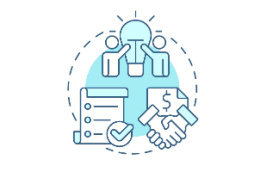What Are the Stages of a Contract's Lifecycle?

With a compound annual growth rate of 13% and the worldwide market set to grow by more than triple from 2020 to 2030, the adoption rate for contract lifecycle management (CLM) software is expanding exponentially. But what are the stages of a contract lifecycle, exactly? Understanding each one can help clarify why such software is necessary in this day and age. While the use of generalized CLM software is on the rise, integrating highly specialized tools at various stages also adds tremendous business value—especially for companies looking to become more competitive and accelerate growth.

What Are the Stages of a Contract’s Lifecycle?
There are eight stages in contract management—each with its own set of tasks and challenges that can be tackled via modern legal technology.
1. Conception
- Basic tasks: Companies must determine what types of contracts must be managed, the volume, which standard agreements are necessary, and what should be included in them. During the kick-off stage, staff members are assigned various duties associated with handling the agreement.
- Challenges: High-level expertise is often required to understand the legal issues of running a business. Failure to create appropriate contracts or address certain issues within them can significantly increase risk of unwanted outcomes, including litigation.
- Benefits of technology: Companies must set up the right processes to increase transparency and alleviate bottlenecks. Putting together a standard template and corporate legal playbook, for example, ensures that all reasonably foreseeable issues will be accounted for.
- Basic tasks: Contract authoring typically begins with a template and standard inclusions followed by the addition of terms, conditions, obligations, key dates, and counterparty considerations.
- Challenges: The key challenge of this stage is creating a draft that satisfies the company’s needs while reducing risks. Errors, omissions, and deviations from strategic company positioning can create compliance problems later.
- Benefits of technology: While templates and clause libraries are helpful, companies can go one step further by leveraging automated technology to compare new drafts alongside legal playbooks and boilerplate language—ensuring all standards are consistently enforced.
3. Redlining
- Basic tasks: Once a contract has been drafted, a junior-level attorney combs through it and redlines errors or potential risks. Heavily redlined drafts may be escalated to a senior lawyer for more in-depth evaluation.
- Challenges: Time is the biggest factor in redlining and review processes, often stretching on for weeks. Junior-level attorneys may find the work tedious and menial while senior lawyers bogged down in line-by-line review lose time they could have otherwise spent on improving the company’s strategic positioning.
- Benefits of technology: The most advanced contract redlining and review solutions can complete full redlining in under five minutes. Staff can then implement corrections at the click of a button or read through contextual suggestions to strengthen their knowledge and bargaining positions.
4. Negotiation
- Basic tasks: Parties share their expectations for the contract, collaborating to reach mutually agreeable terms and conditions. Recommended changes and amendments may be requested by any party at any time to limit risk and increase contract success.
- Challenges: Negotiations between parties can add weeks onto the process, especially if the rationale for changes remains murky. Back-and-forth email clarifications, retrieving contextual documents, and multi-level reviews further add time.
- Benefits of technology: High-level contract negotiation software harnesses the very best of natural language processing (NLP), artificial intelligence (AI), and machine learning technology to identify risky passages and provide suggestions based on corporate legal playbooks and attorney inputs. Parties receive contextual recommendations with links to documents that can help reviewers understand the reasoning behind certain markups. Automated assistance greatly reduces time spent emailing or trying to deduce impetus for change.
5. Final Drafting
- Basic tasks: Once negotiations have been agreed upon, the contract goes through a final writing and review cycle by each party.
- Challenges: A slow chain of command or unavailable staff can delay approvals. Some companies may experience difficulty in tracking different versions or changes in a contract draft, leading to errors or inefficiencies.
- Benefits of technology: The right technology provides full visibility into the drafting process, uniting all versions into one final agreement where changes are easily viewable. Technology can also auto-store and save files correctly.
6. Signing
- Basic tasks: Authorized agents from both parties sign the contract and share any signed versions, putting contract terms and conditions into motion.
- Challenges: In the past, companies put paper contracts in the mail. Wet signatures can take a while as they’re prone to loss, delays, and fraud.
- Benefits of technology: E-signatures have become increasingly commonplace, allowing business leaders to execute secure agreements almost instantaneously.
7. Execution
- Basic tasks: Once executed, contractual obligations, including deliverables and deadlines, must be tracked. Task approvals, spend management, and ongoing regulatory compliance may require monitoring as well.
- Challenges: Late fees, litigation expenses, and bottlenecks can all arise when contracts are not well-monitored and managed. Lost contracts make tracking even more difficult.
- Benefits of technology: Centralized, searchable repositories with built-in tracking capabilities ensure the company can lay a solid foundation for effective contract execution management.
8. Renewal
- Basic tasks: The final stage of the contract lifecycle is initiated once a relationship between parties reaches the end of its lifespan. Contracts can be set to default, auto-terminate, auto-renew, or go through a renegotiation cycle.
- Challenges: Failure to act can sometimes result in penalties, default actions, or increased liabilities. A careless approach to renewal management can cause a company’s relationships with others to suffer—making it less profitable overall.
- Benefits of technology: Implementing proactive review and renegotiation processes helps companies manage obligations and opportunities with greater efficiency.
LexCheck: A Modern Contract Review and Negotiation Tool
LexCheck, powered by breakthrough AI and automation technology, helps businesses accelerate the contract redlining and negotiation processes—shaving off weeks’ worth of time in a contract’s lifecycle.
Here’s how it works:
- Upon creating an AI Digital Playbook, the system is preloaded with a company’s proprietary contracting and negotiation best practices.
- Newly drafted contracts can be easily delivered to the system for review via email.
- LexCheck then redlines and reviews an uploaded contract for errors, deviations, and risks.
- A fully redlined contract is produced within five minutes.
- Changes can be made with the click of a button.
- Contextual notes are included for all revision suggestions, cost-effectively training reviewers while forming the basis for negotiations with other parties.
- Lawyers can also add “if/then” automation rules to train the system to make specific edits.
Lawyers are always needed to take the final pass on a contract, as there’s still no substitute for shrewd, strategic business sense. However, by letting AI technology take the reins on error-prone, manual review processes, companies alleviate risk, accelerate business cycles, and guarantee that company standards are always maintained.
What are the stages of a contract’s lifecycle? And how can you use the latest legal tech solutions to streamline each one? We’ll show you. Contact us at sales@lexcheck.com or request a demo today.